Primary Health Care Question Answer 2022
VerifiedAdded on 2022/09/28
|11
|3298
|21
AI Summary
Contribute Materials
Your contribution can guide someone’s learning journey. Share your
documents today.
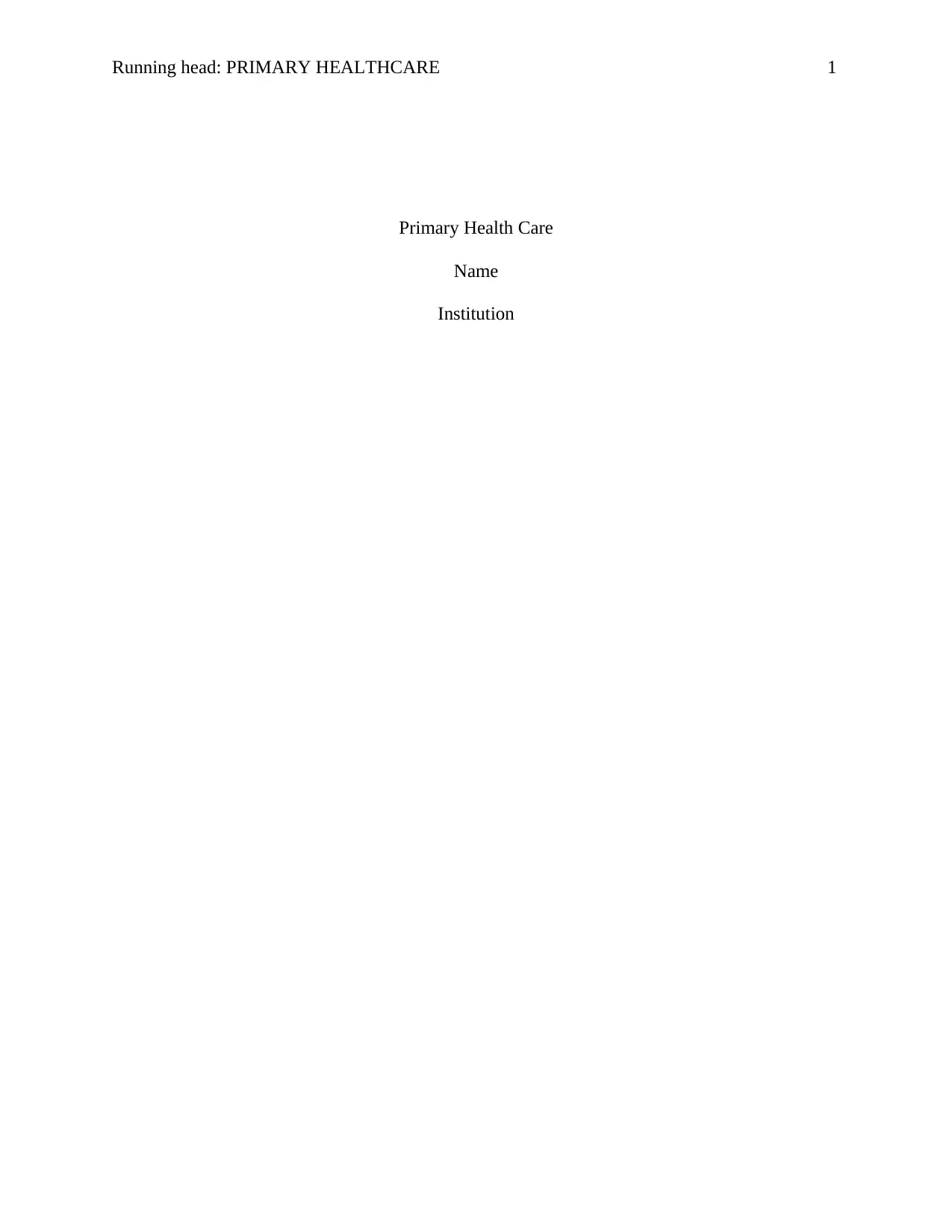
Running head: PRIMARY HEALTHCARE 1
Primary Health Care
Name
Institution
Primary Health Care
Name
Institution
Secure Best Marks with AI Grader
Need help grading? Try our AI Grader for instant feedback on your assignments.
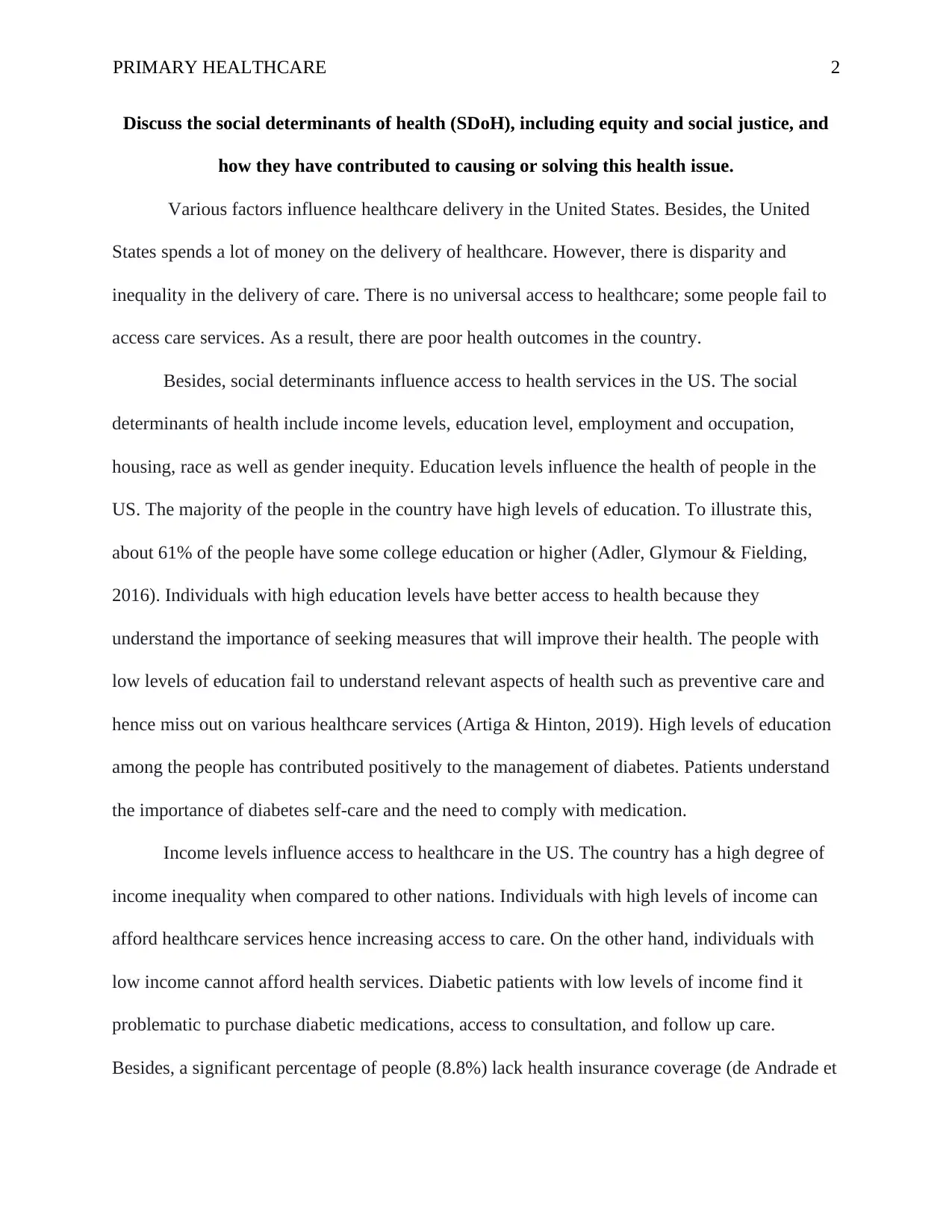
PRIMARY HEALTHCARE 2
Discuss the social determinants of health (SDoH), including equity and social justice, and
how they have contributed to causing or solving this health issue.
Various factors influence healthcare delivery in the United States. Besides, the United
States spends a lot of money on the delivery of healthcare. However, there is disparity and
inequality in the delivery of care. There is no universal access to healthcare; some people fail to
access care services. As a result, there are poor health outcomes in the country.
Besides, social determinants influence access to health services in the US. The social
determinants of health include income levels, education level, employment and occupation,
housing, race as well as gender inequity. Education levels influence the health of people in the
US. The majority of the people in the country have high levels of education. To illustrate this,
about 61% of the people have some college education or higher (Adler, Glymour & Fielding,
2016). Individuals with high education levels have better access to health because they
understand the importance of seeking measures that will improve their health. The people with
low levels of education fail to understand relevant aspects of health such as preventive care and
hence miss out on various healthcare services (Artiga & Hinton, 2019). High levels of education
among the people has contributed positively to the management of diabetes. Patients understand
the importance of diabetes self-care and the need to comply with medication.
Income levels influence access to healthcare in the US. The country has a high degree of
income inequality when compared to other nations. Individuals with high levels of income can
afford healthcare services hence increasing access to care. On the other hand, individuals with
low income cannot afford health services. Diabetic patients with low levels of income find it
problematic to purchase diabetic medications, access to consultation, and follow up care.
Besides, a significant percentage of people (8.8%) lack health insurance coverage (de Andrade et
Discuss the social determinants of health (SDoH), including equity and social justice, and
how they have contributed to causing or solving this health issue.
Various factors influence healthcare delivery in the United States. Besides, the United
States spends a lot of money on the delivery of healthcare. However, there is disparity and
inequality in the delivery of care. There is no universal access to healthcare; some people fail to
access care services. As a result, there are poor health outcomes in the country.
Besides, social determinants influence access to health services in the US. The social
determinants of health include income levels, education level, employment and occupation,
housing, race as well as gender inequity. Education levels influence the health of people in the
US. The majority of the people in the country have high levels of education. To illustrate this,
about 61% of the people have some college education or higher (Adler, Glymour & Fielding,
2016). Individuals with high education levels have better access to health because they
understand the importance of seeking measures that will improve their health. The people with
low levels of education fail to understand relevant aspects of health such as preventive care and
hence miss out on various healthcare services (Artiga & Hinton, 2019). High levels of education
among the people has contributed positively to the management of diabetes. Patients understand
the importance of diabetes self-care and the need to comply with medication.
Income levels influence access to healthcare in the US. The country has a high degree of
income inequality when compared to other nations. Individuals with high levels of income can
afford healthcare services hence increasing access to care. On the other hand, individuals with
low income cannot afford health services. Diabetic patients with low levels of income find it
problematic to purchase diabetic medications, access to consultation, and follow up care.
Besides, a significant percentage of people (8.8%) lack health insurance coverage (de Andrade et
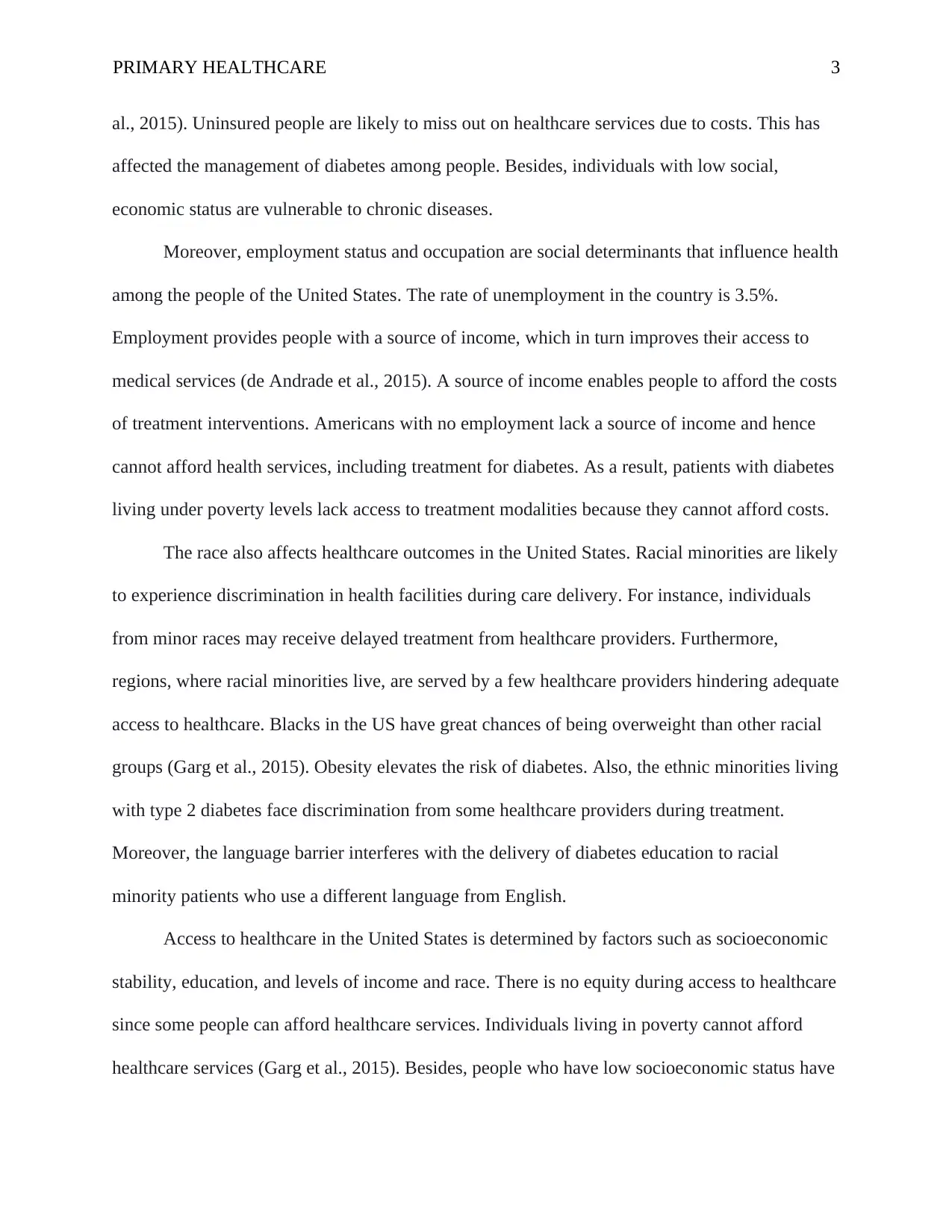
PRIMARY HEALTHCARE 3
al., 2015). Uninsured people are likely to miss out on healthcare services due to costs. This has
affected the management of diabetes among people. Besides, individuals with low social,
economic status are vulnerable to chronic diseases.
Moreover, employment status and occupation are social determinants that influence health
among the people of the United States. The rate of unemployment in the country is 3.5%.
Employment provides people with a source of income, which in turn improves their access to
medical services (de Andrade et al., 2015). A source of income enables people to afford the costs
of treatment interventions. Americans with no employment lack a source of income and hence
cannot afford health services, including treatment for diabetes. As a result, patients with diabetes
living under poverty levels lack access to treatment modalities because they cannot afford costs.
The race also affects healthcare outcomes in the United States. Racial minorities are likely
to experience discrimination in health facilities during care delivery. For instance, individuals
from minor races may receive delayed treatment from healthcare providers. Furthermore,
regions, where racial minorities live, are served by a few healthcare providers hindering adequate
access to healthcare. Blacks in the US have great chances of being overweight than other racial
groups (Garg et al., 2015). Obesity elevates the risk of diabetes. Also, the ethnic minorities living
with type 2 diabetes face discrimination from some healthcare providers during treatment.
Moreover, the language barrier interferes with the delivery of diabetes education to racial
minority patients who use a different language from English.
Access to healthcare in the United States is determined by factors such as socioeconomic
stability, education, and levels of income and race. There is no equity during access to healthcare
since some people can afford healthcare services. Individuals living in poverty cannot afford
healthcare services (Garg et al., 2015). Besides, people who have low socioeconomic status have
al., 2015). Uninsured people are likely to miss out on healthcare services due to costs. This has
affected the management of diabetes among people. Besides, individuals with low social,
economic status are vulnerable to chronic diseases.
Moreover, employment status and occupation are social determinants that influence health
among the people of the United States. The rate of unemployment in the country is 3.5%.
Employment provides people with a source of income, which in turn improves their access to
medical services (de Andrade et al., 2015). A source of income enables people to afford the costs
of treatment interventions. Americans with no employment lack a source of income and hence
cannot afford health services, including treatment for diabetes. As a result, patients with diabetes
living under poverty levels lack access to treatment modalities because they cannot afford costs.
The race also affects healthcare outcomes in the United States. Racial minorities are likely
to experience discrimination in health facilities during care delivery. For instance, individuals
from minor races may receive delayed treatment from healthcare providers. Furthermore,
regions, where racial minorities live, are served by a few healthcare providers hindering adequate
access to healthcare. Blacks in the US have great chances of being overweight than other racial
groups (Garg et al., 2015). Obesity elevates the risk of diabetes. Also, the ethnic minorities living
with type 2 diabetes face discrimination from some healthcare providers during treatment.
Moreover, the language barrier interferes with the delivery of diabetes education to racial
minority patients who use a different language from English.
Access to healthcare in the United States is determined by factors such as socioeconomic
stability, education, and levels of income and race. There is no equity during access to healthcare
since some people can afford healthcare services. Individuals living in poverty cannot afford
healthcare services (Garg et al., 2015). Besides, people who have low socioeconomic status have
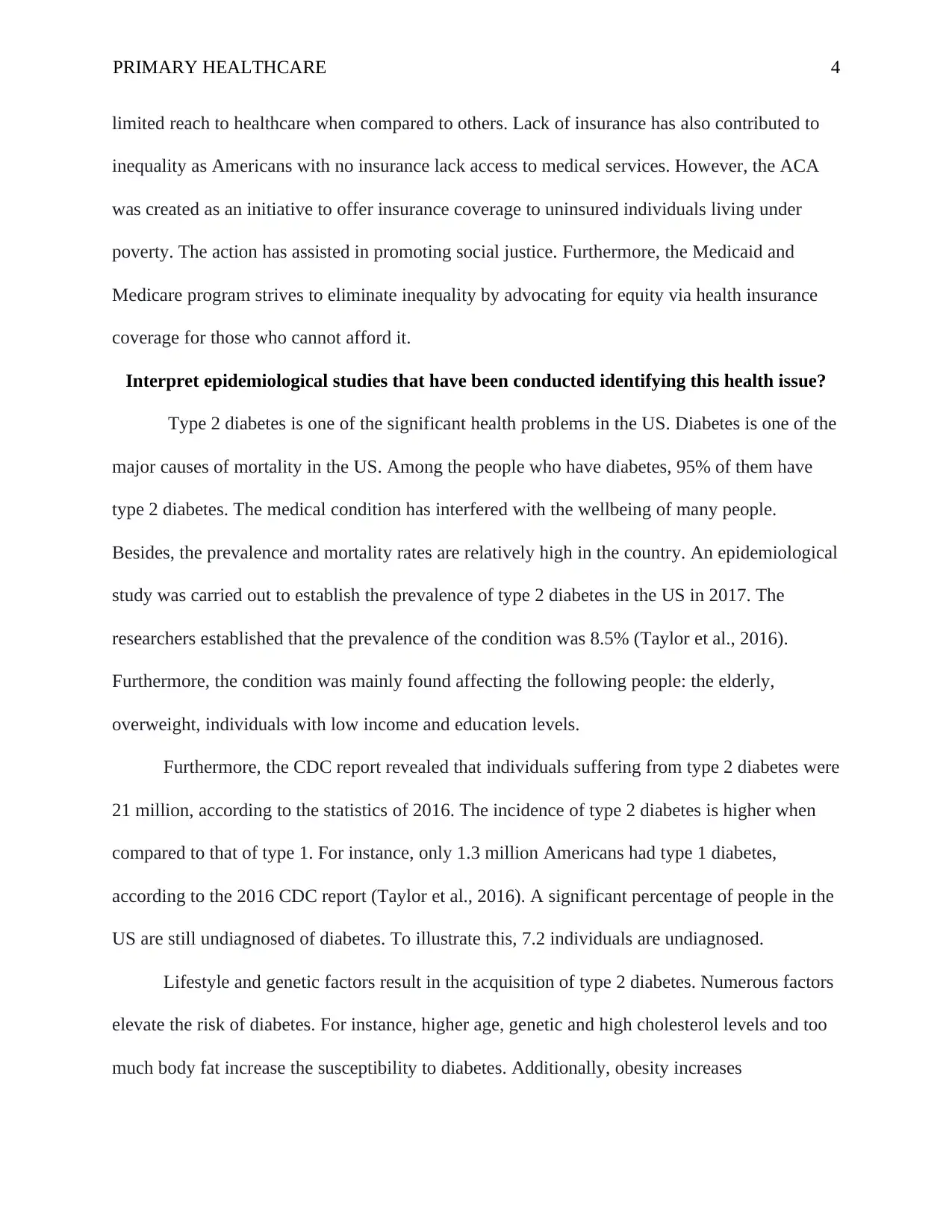
PRIMARY HEALTHCARE 4
limited reach to healthcare when compared to others. Lack of insurance has also contributed to
inequality as Americans with no insurance lack access to medical services. However, the ACA
was created as an initiative to offer insurance coverage to uninsured individuals living under
poverty. The action has assisted in promoting social justice. Furthermore, the Medicaid and
Medicare program strives to eliminate inequality by advocating for equity via health insurance
coverage for those who cannot afford it.
Interpret epidemiological studies that have been conducted identifying this health issue?
Type 2 diabetes is one of the significant health problems in the US. Diabetes is one of the
major causes of mortality in the US. Among the people who have diabetes, 95% of them have
type 2 diabetes. The medical condition has interfered with the wellbeing of many people.
Besides, the prevalence and mortality rates are relatively high in the country. An epidemiological
study was carried out to establish the prevalence of type 2 diabetes in the US in 2017. The
researchers established that the prevalence of the condition was 8.5% (Taylor et al., 2016).
Furthermore, the condition was mainly found affecting the following people: the elderly,
overweight, individuals with low income and education levels.
Furthermore, the CDC report revealed that individuals suffering from type 2 diabetes were
21 million, according to the statistics of 2016. The incidence of type 2 diabetes is higher when
compared to that of type 1. For instance, only 1.3 million Americans had type 1 diabetes,
according to the 2016 CDC report (Taylor et al., 2016). A significant percentage of people in the
US are still undiagnosed of diabetes. To illustrate this, 7.2 individuals are undiagnosed.
Lifestyle and genetic factors result in the acquisition of type 2 diabetes. Numerous factors
elevate the risk of diabetes. For instance, higher age, genetic and high cholesterol levels and too
much body fat increase the susceptibility to diabetes. Additionally, obesity increases
limited reach to healthcare when compared to others. Lack of insurance has also contributed to
inequality as Americans with no insurance lack access to medical services. However, the ACA
was created as an initiative to offer insurance coverage to uninsured individuals living under
poverty. The action has assisted in promoting social justice. Furthermore, the Medicaid and
Medicare program strives to eliminate inequality by advocating for equity via health insurance
coverage for those who cannot afford it.
Interpret epidemiological studies that have been conducted identifying this health issue?
Type 2 diabetes is one of the significant health problems in the US. Diabetes is one of the
major causes of mortality in the US. Among the people who have diabetes, 95% of them have
type 2 diabetes. The medical condition has interfered with the wellbeing of many people.
Besides, the prevalence and mortality rates are relatively high in the country. An epidemiological
study was carried out to establish the prevalence of type 2 diabetes in the US in 2017. The
researchers established that the prevalence of the condition was 8.5% (Taylor et al., 2016).
Furthermore, the condition was mainly found affecting the following people: the elderly,
overweight, individuals with low income and education levels.
Furthermore, the CDC report revealed that individuals suffering from type 2 diabetes were
21 million, according to the statistics of 2016. The incidence of type 2 diabetes is higher when
compared to that of type 1. For instance, only 1.3 million Americans had type 1 diabetes,
according to the 2016 CDC report (Taylor et al., 2016). A significant percentage of people in the
US are still undiagnosed of diabetes. To illustrate this, 7.2 individuals are undiagnosed.
Lifestyle and genetic factors result in the acquisition of type 2 diabetes. Numerous factors
elevate the risk of diabetes. For instance, higher age, genetic and high cholesterol levels and too
much body fat increase the susceptibility to diabetes. Additionally, obesity increases
Secure Best Marks with AI Grader
Need help grading? Try our AI Grader for instant feedback on your assignments.

PRIMARY HEALTHCARE 5
vulnerability to type 2 diabetes. Over the past years, obesity prevalence has increased
significantly in the US. The majority of obese people in the US also have diabetes. Obesity
elevates the susceptibility to type 2 diabetes because obese people possess excess fat around the
waist and upper body regions.
The development of type 2 diabetes also varies between races. Factors that cause
variation in prevalence rates among ethnic groups in the US include healthcare access,
environment, finances, lifestyle, health conditions, and genetics. The Non-Hispanics Blacks are
the racial group that has the highest number of people affected with diabetes mellitus (12.7%)
(Chen et al, 2015). The prevalence rate among other ethnicities includes 12.1 % among the
Hispanics, 8% among the Asian Americans, and 7.4% among the non-Hispanic Whites.
The mortality rate of type 2 diabetes is high in the US. Every year, 79,535 Americans die
due to diabetes. People with type 2 diabetes have 1.8 chances of experiencing premature death
when compared to the people living without the condition (Chen et al, 2015). Besides, type 2
diabetes has increased the risk of cardiovascular disorders among people, which in turn increased
the death rate due to these conditions. Also, type 2 diabetes has contributed to the development
of blindness among adults, lower limb amputations, and kidney failure.
Management of type 2 diabetes has elevated healthcare costs in the United States. To
illustrate this, the country spent 327 billion dollars in the management of diabetes in 2017. This
included decreased productivity (90 billion dollars) and medical costs (237 billion dollars).
Moreover, people have to incur the cost of treating the condition and follow up care.
Various treatment modalities are used to manage people affected by type 2 diabetes in the
US (Cho et al., 2018). The management interventions include monitoring blood sugar, uptake of
vulnerability to type 2 diabetes. Over the past years, obesity prevalence has increased
significantly in the US. The majority of obese people in the US also have diabetes. Obesity
elevates the susceptibility to type 2 diabetes because obese people possess excess fat around the
waist and upper body regions.
The development of type 2 diabetes also varies between races. Factors that cause
variation in prevalence rates among ethnic groups in the US include healthcare access,
environment, finances, lifestyle, health conditions, and genetics. The Non-Hispanics Blacks are
the racial group that has the highest number of people affected with diabetes mellitus (12.7%)
(Chen et al, 2015). The prevalence rate among other ethnicities includes 12.1 % among the
Hispanics, 8% among the Asian Americans, and 7.4% among the non-Hispanic Whites.
The mortality rate of type 2 diabetes is high in the US. Every year, 79,535 Americans die
due to diabetes. People with type 2 diabetes have 1.8 chances of experiencing premature death
when compared to the people living without the condition (Chen et al, 2015). Besides, type 2
diabetes has increased the risk of cardiovascular disorders among people, which in turn increased
the death rate due to these conditions. Also, type 2 diabetes has contributed to the development
of blindness among adults, lower limb amputations, and kidney failure.
Management of type 2 diabetes has elevated healthcare costs in the United States. To
illustrate this, the country spent 327 billion dollars in the management of diabetes in 2017. This
included decreased productivity (90 billion dollars) and medical costs (237 billion dollars).
Moreover, people have to incur the cost of treating the condition and follow up care.
Various treatment modalities are used to manage people affected by type 2 diabetes in the
US (Cho et al., 2018). The management interventions include monitoring blood sugar, uptake of
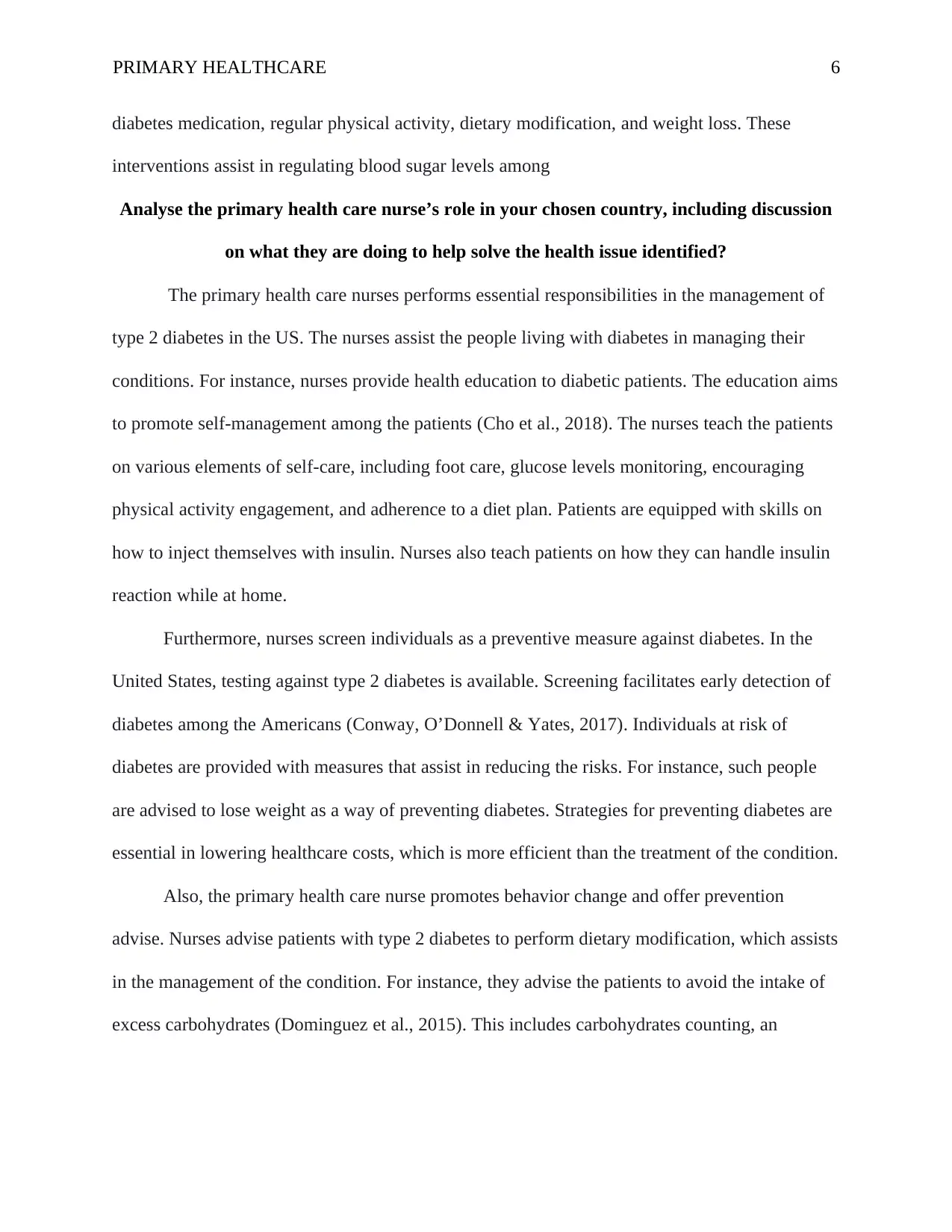
PRIMARY HEALTHCARE 6
diabetes medication, regular physical activity, dietary modification, and weight loss. These
interventions assist in regulating blood sugar levels among
Analyse the primary health care nurse’s role in your chosen country, including discussion
on what they are doing to help solve the health issue identified?
The primary health care nurses performs essential responsibilities in the management of
type 2 diabetes in the US. The nurses assist the people living with diabetes in managing their
conditions. For instance, nurses provide health education to diabetic patients. The education aims
to promote self-management among the patients (Cho et al., 2018). The nurses teach the patients
on various elements of self-care, including foot care, glucose levels monitoring, encouraging
physical activity engagement, and adherence to a diet plan. Patients are equipped with skills on
how to inject themselves with insulin. Nurses also teach patients on how they can handle insulin
reaction while at home.
Furthermore, nurses screen individuals as a preventive measure against diabetes. In the
United States, testing against type 2 diabetes is available. Screening facilitates early detection of
diabetes among the Americans (Conway, O’Donnell & Yates, 2017). Individuals at risk of
diabetes are provided with measures that assist in reducing the risks. For instance, such people
are advised to lose weight as a way of preventing diabetes. Strategies for preventing diabetes are
essential in lowering healthcare costs, which is more efficient than the treatment of the condition.
Also, the primary health care nurse promotes behavior change and offer prevention
advise. Nurses advise patients with type 2 diabetes to perform dietary modification, which assists
in the management of the condition. For instance, they advise the patients to avoid the intake of
excess carbohydrates (Dominguez et al., 2015). This includes carbohydrates counting, an
diabetes medication, regular physical activity, dietary modification, and weight loss. These
interventions assist in regulating blood sugar levels among
Analyse the primary health care nurse’s role in your chosen country, including discussion
on what they are doing to help solve the health issue identified?
The primary health care nurses performs essential responsibilities in the management of
type 2 diabetes in the US. The nurses assist the people living with diabetes in managing their
conditions. For instance, nurses provide health education to diabetic patients. The education aims
to promote self-management among the patients (Cho et al., 2018). The nurses teach the patients
on various elements of self-care, including foot care, glucose levels monitoring, encouraging
physical activity engagement, and adherence to a diet plan. Patients are equipped with skills on
how to inject themselves with insulin. Nurses also teach patients on how they can handle insulin
reaction while at home.
Furthermore, nurses screen individuals as a preventive measure against diabetes. In the
United States, testing against type 2 diabetes is available. Screening facilitates early detection of
diabetes among the Americans (Conway, O’Donnell & Yates, 2017). Individuals at risk of
diabetes are provided with measures that assist in reducing the risks. For instance, such people
are advised to lose weight as a way of preventing diabetes. Strategies for preventing diabetes are
essential in lowering healthcare costs, which is more efficient than the treatment of the condition.
Also, the primary health care nurse promotes behavior change and offer prevention
advise. Nurses advise patients with type 2 diabetes to perform dietary modification, which assists
in the management of the condition. For instance, they advise the patients to avoid the intake of
excess carbohydrates (Dominguez et al., 2015). This includes carbohydrates counting, an
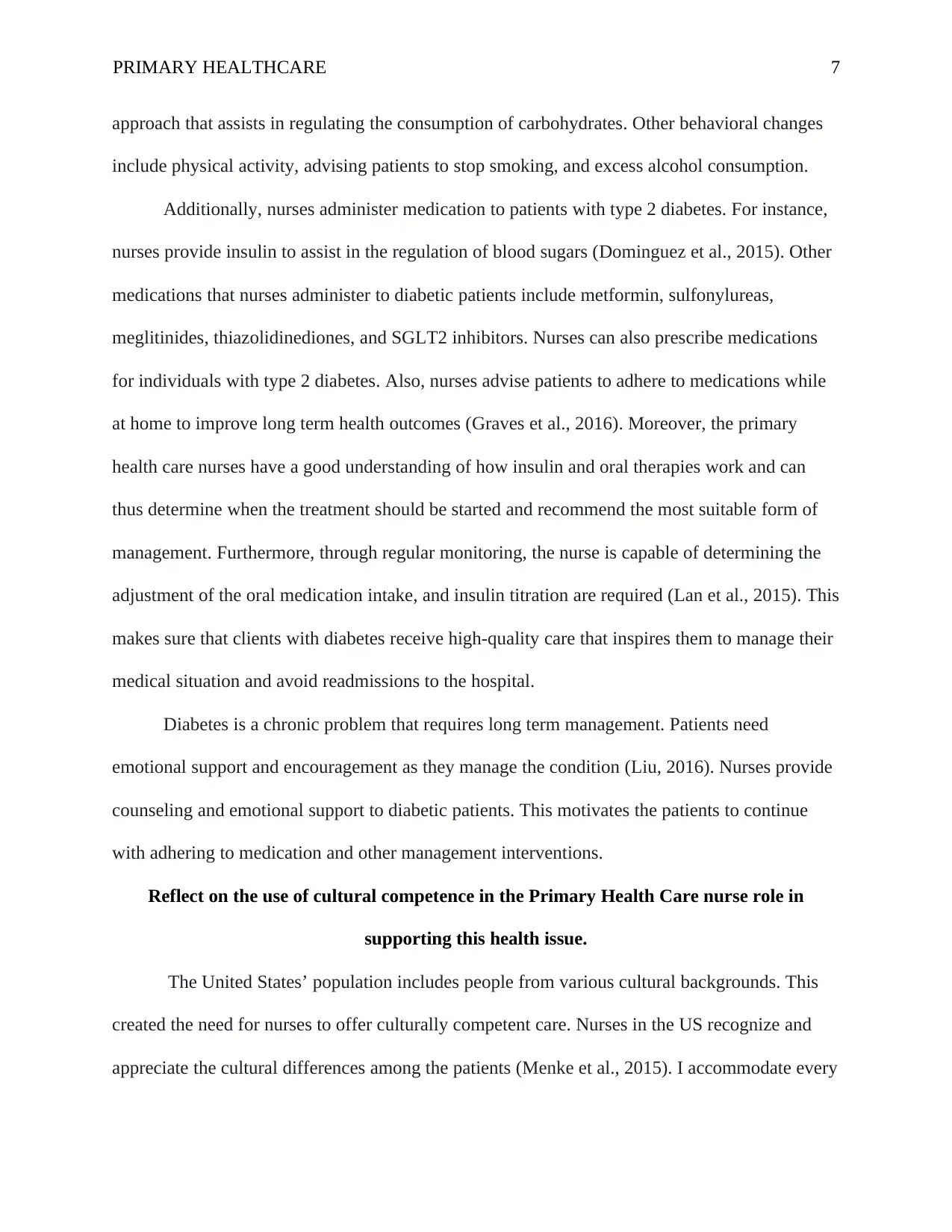
PRIMARY HEALTHCARE 7
approach that assists in regulating the consumption of carbohydrates. Other behavioral changes
include physical activity, advising patients to stop smoking, and excess alcohol consumption.
Additionally, nurses administer medication to patients with type 2 diabetes. For instance,
nurses provide insulin to assist in the regulation of blood sugars (Dominguez et al., 2015). Other
medications that nurses administer to diabetic patients include metformin, sulfonylureas,
meglitinides, thiazolidinediones, and SGLT2 inhibitors. Nurses can also prescribe medications
for individuals with type 2 diabetes. Also, nurses advise patients to adhere to medications while
at home to improve long term health outcomes (Graves et al., 2016). Moreover, the primary
health care nurses have a good understanding of how insulin and oral therapies work and can
thus determine when the treatment should be started and recommend the most suitable form of
management. Furthermore, through regular monitoring, the nurse is capable of determining the
adjustment of the oral medication intake, and insulin titration are required (Lan et al., 2015). This
makes sure that clients with diabetes receive high-quality care that inspires them to manage their
medical situation and avoid readmissions to the hospital.
Diabetes is a chronic problem that requires long term management. Patients need
emotional support and encouragement as they manage the condition (Liu, 2016). Nurses provide
counseling and emotional support to diabetic patients. This motivates the patients to continue
with adhering to medication and other management interventions.
Reflect on the use of cultural competence in the Primary Health Care nurse role in
supporting this health issue.
The United States’ population includes people from various cultural backgrounds. This
created the need for nurses to offer culturally competent care. Nurses in the US recognize and
appreciate the cultural differences among the patients (Menke et al., 2015). I accommodate every
approach that assists in regulating the consumption of carbohydrates. Other behavioral changes
include physical activity, advising patients to stop smoking, and excess alcohol consumption.
Additionally, nurses administer medication to patients with type 2 diabetes. For instance,
nurses provide insulin to assist in the regulation of blood sugars (Dominguez et al., 2015). Other
medications that nurses administer to diabetic patients include metformin, sulfonylureas,
meglitinides, thiazolidinediones, and SGLT2 inhibitors. Nurses can also prescribe medications
for individuals with type 2 diabetes. Also, nurses advise patients to adhere to medications while
at home to improve long term health outcomes (Graves et al., 2016). Moreover, the primary
health care nurses have a good understanding of how insulin and oral therapies work and can
thus determine when the treatment should be started and recommend the most suitable form of
management. Furthermore, through regular monitoring, the nurse is capable of determining the
adjustment of the oral medication intake, and insulin titration are required (Lan et al., 2015). This
makes sure that clients with diabetes receive high-quality care that inspires them to manage their
medical situation and avoid readmissions to the hospital.
Diabetes is a chronic problem that requires long term management. Patients need
emotional support and encouragement as they manage the condition (Liu, 2016). Nurses provide
counseling and emotional support to diabetic patients. This motivates the patients to continue
with adhering to medication and other management interventions.
Reflect on the use of cultural competence in the Primary Health Care nurse role in
supporting this health issue.
The United States’ population includes people from various cultural backgrounds. This
created the need for nurses to offer culturally competent care. Nurses in the US recognize and
appreciate the cultural differences among the patients (Menke et al., 2015). I accommodate every
Paraphrase This Document
Need a fresh take? Get an instant paraphrase of this document with our AI Paraphraser
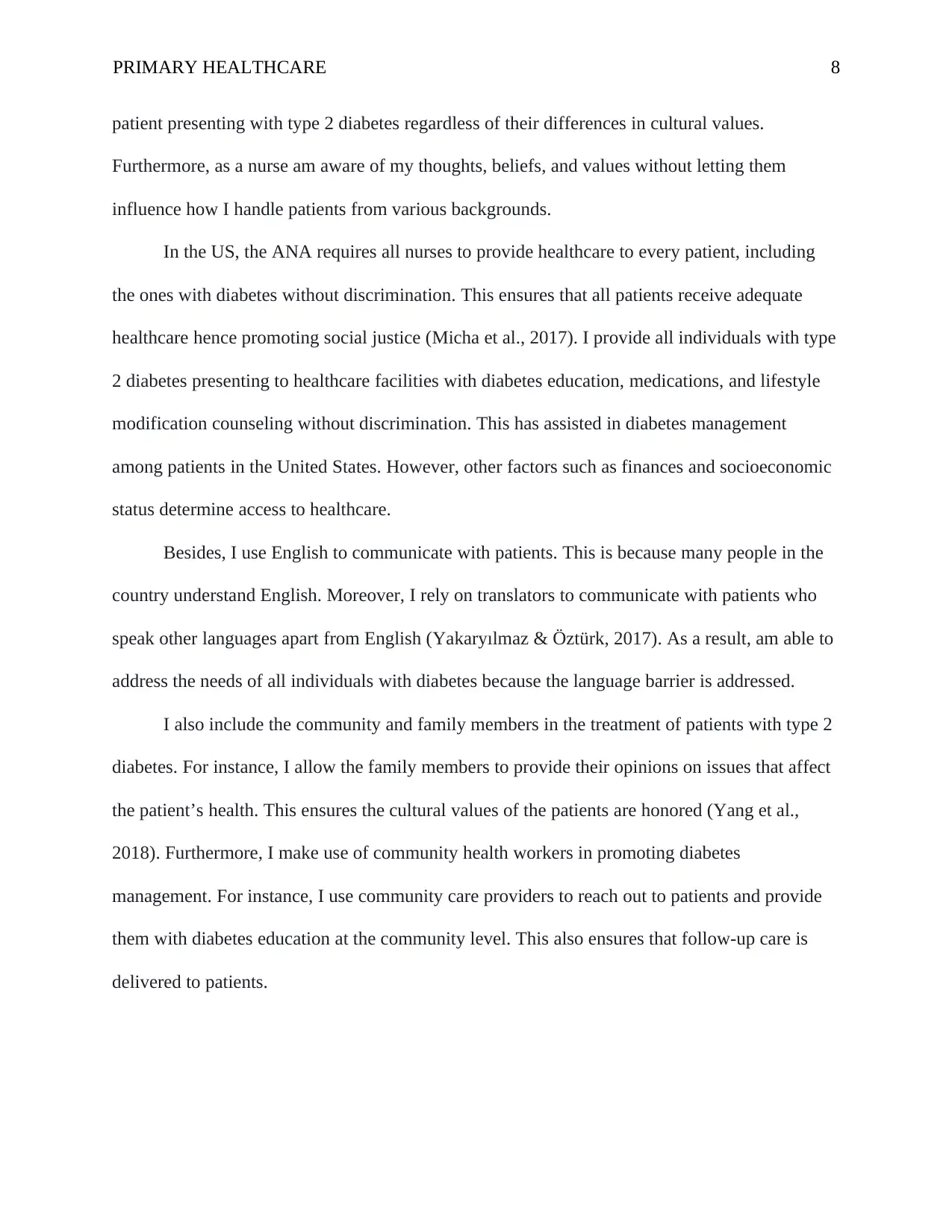
PRIMARY HEALTHCARE 8
patient presenting with type 2 diabetes regardless of their differences in cultural values.
Furthermore, as a nurse am aware of my thoughts, beliefs, and values without letting them
influence how I handle patients from various backgrounds.
In the US, the ANA requires all nurses to provide healthcare to every patient, including
the ones with diabetes without discrimination. This ensures that all patients receive adequate
healthcare hence promoting social justice (Micha et al., 2017). I provide all individuals with type
2 diabetes presenting to healthcare facilities with diabetes education, medications, and lifestyle
modification counseling without discrimination. This has assisted in diabetes management
among patients in the United States. However, other factors such as finances and socioeconomic
status determine access to healthcare.
Besides, I use English to communicate with patients. This is because many people in the
country understand English. Moreover, I rely on translators to communicate with patients who
speak other languages apart from English (Yakaryılmaz & Öztürk, 2017). As a result, am able to
address the needs of all individuals with diabetes because the language barrier is addressed.
I also include the community and family members in the treatment of patients with type 2
diabetes. For instance, I allow the family members to provide their opinions on issues that affect
the patient’s health. This ensures the cultural values of the patients are honored (Yang et al.,
2018). Furthermore, I make use of community health workers in promoting diabetes
management. For instance, I use community care providers to reach out to patients and provide
them with diabetes education at the community level. This also ensures that follow-up care is
delivered to patients.
patient presenting with type 2 diabetes regardless of their differences in cultural values.
Furthermore, as a nurse am aware of my thoughts, beliefs, and values without letting them
influence how I handle patients from various backgrounds.
In the US, the ANA requires all nurses to provide healthcare to every patient, including
the ones with diabetes without discrimination. This ensures that all patients receive adequate
healthcare hence promoting social justice (Micha et al., 2017). I provide all individuals with type
2 diabetes presenting to healthcare facilities with diabetes education, medications, and lifestyle
modification counseling without discrimination. This has assisted in diabetes management
among patients in the United States. However, other factors such as finances and socioeconomic
status determine access to healthcare.
Besides, I use English to communicate with patients. This is because many people in the
country understand English. Moreover, I rely on translators to communicate with patients who
speak other languages apart from English (Yakaryılmaz & Öztürk, 2017). As a result, am able to
address the needs of all individuals with diabetes because the language barrier is addressed.
I also include the community and family members in the treatment of patients with type 2
diabetes. For instance, I allow the family members to provide their opinions on issues that affect
the patient’s health. This ensures the cultural values of the patients are honored (Yang et al.,
2018). Furthermore, I make use of community health workers in promoting diabetes
management. For instance, I use community care providers to reach out to patients and provide
them with diabetes education at the community level. This also ensures that follow-up care is
delivered to patients.
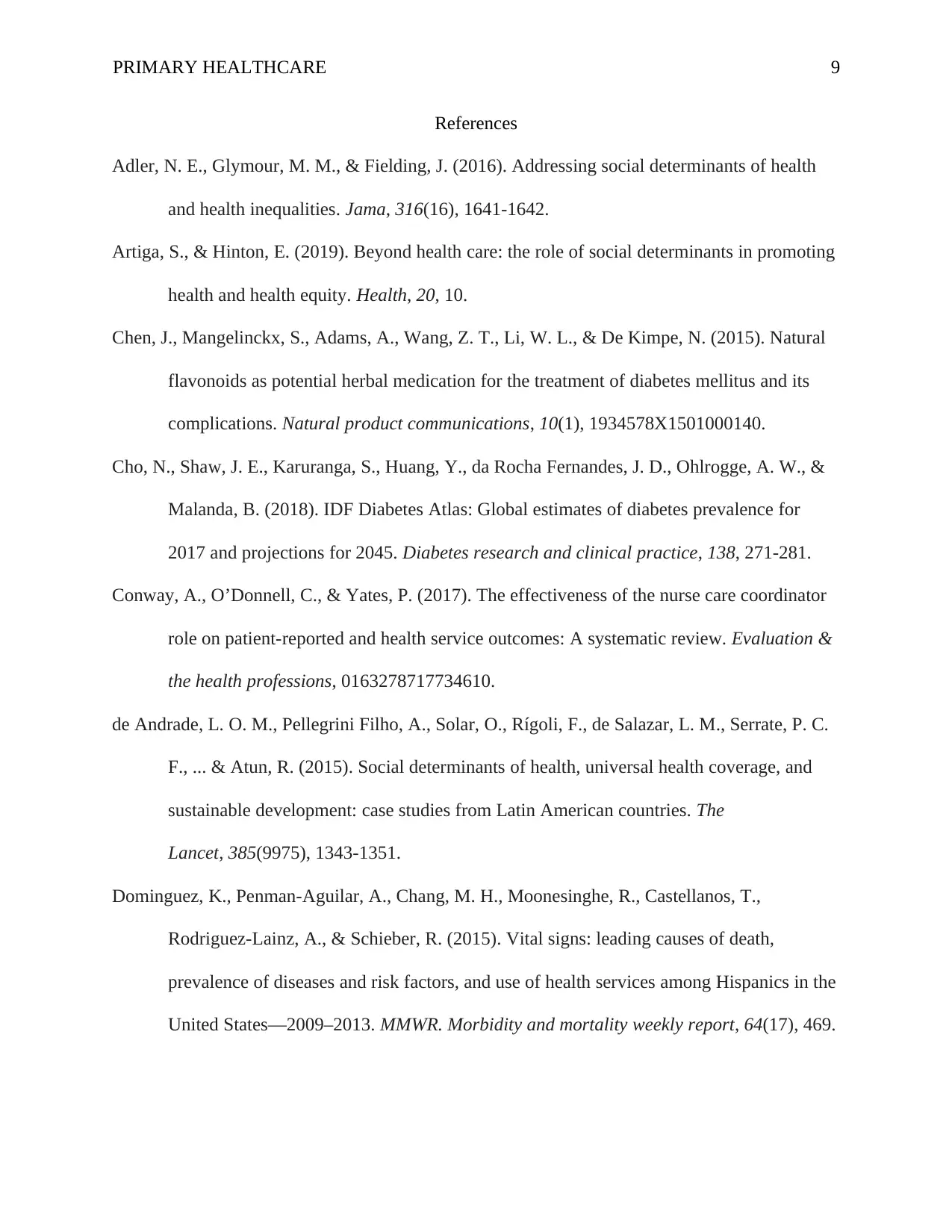
PRIMARY HEALTHCARE 9
References
Adler, N. E., Glymour, M. M., & Fielding, J. (2016). Addressing social determinants of health
and health inequalities. Jama, 316(16), 1641-1642.
Artiga, S., & Hinton, E. (2019). Beyond health care: the role of social determinants in promoting
health and health equity. Health, 20, 10.
Chen, J., Mangelinckx, S., Adams, A., Wang, Z. T., Li, W. L., & De Kimpe, N. (2015). Natural
flavonoids as potential herbal medication for the treatment of diabetes mellitus and its
complications. Natural product communications, 10(1), 1934578X1501000140.
Cho, N., Shaw, J. E., Karuranga, S., Huang, Y., da Rocha Fernandes, J. D., Ohlrogge, A. W., &
Malanda, B. (2018). IDF Diabetes Atlas: Global estimates of diabetes prevalence for
2017 and projections for 2045. Diabetes research and clinical practice, 138, 271-281.
Conway, A., O’Donnell, C., & Yates, P. (2017). The effectiveness of the nurse care coordinator
role on patient-reported and health service outcomes: A systematic review. Evaluation &
the health professions, 0163278717734610.
de Andrade, L. O. M., Pellegrini Filho, A., Solar, O., Rígoli, F., de Salazar, L. M., Serrate, P. C.
F., ... & Atun, R. (2015). Social determinants of health, universal health coverage, and
sustainable development: case studies from Latin American countries. The
Lancet, 385(9975), 1343-1351.
Dominguez, K., Penman-Aguilar, A., Chang, M. H., Moonesinghe, R., Castellanos, T.,
Rodriguez-Lainz, A., & Schieber, R. (2015). Vital signs: leading causes of death,
prevalence of diseases and risk factors, and use of health services among Hispanics in the
United States—2009–2013. MMWR. Morbidity and mortality weekly report, 64(17), 469.
References
Adler, N. E., Glymour, M. M., & Fielding, J. (2016). Addressing social determinants of health
and health inequalities. Jama, 316(16), 1641-1642.
Artiga, S., & Hinton, E. (2019). Beyond health care: the role of social determinants in promoting
health and health equity. Health, 20, 10.
Chen, J., Mangelinckx, S., Adams, A., Wang, Z. T., Li, W. L., & De Kimpe, N. (2015). Natural
flavonoids as potential herbal medication for the treatment of diabetes mellitus and its
complications. Natural product communications, 10(1), 1934578X1501000140.
Cho, N., Shaw, J. E., Karuranga, S., Huang, Y., da Rocha Fernandes, J. D., Ohlrogge, A. W., &
Malanda, B. (2018). IDF Diabetes Atlas: Global estimates of diabetes prevalence for
2017 and projections for 2045. Diabetes research and clinical practice, 138, 271-281.
Conway, A., O’Donnell, C., & Yates, P. (2017). The effectiveness of the nurse care coordinator
role on patient-reported and health service outcomes: A systematic review. Evaluation &
the health professions, 0163278717734610.
de Andrade, L. O. M., Pellegrini Filho, A., Solar, O., Rígoli, F., de Salazar, L. M., Serrate, P. C.
F., ... & Atun, R. (2015). Social determinants of health, universal health coverage, and
sustainable development: case studies from Latin American countries. The
Lancet, 385(9975), 1343-1351.
Dominguez, K., Penman-Aguilar, A., Chang, M. H., Moonesinghe, R., Castellanos, T.,
Rodriguez-Lainz, A., & Schieber, R. (2015). Vital signs: leading causes of death,
prevalence of diseases and risk factors, and use of health services among Hispanics in the
United States—2009–2013. MMWR. Morbidity and mortality weekly report, 64(17), 469.
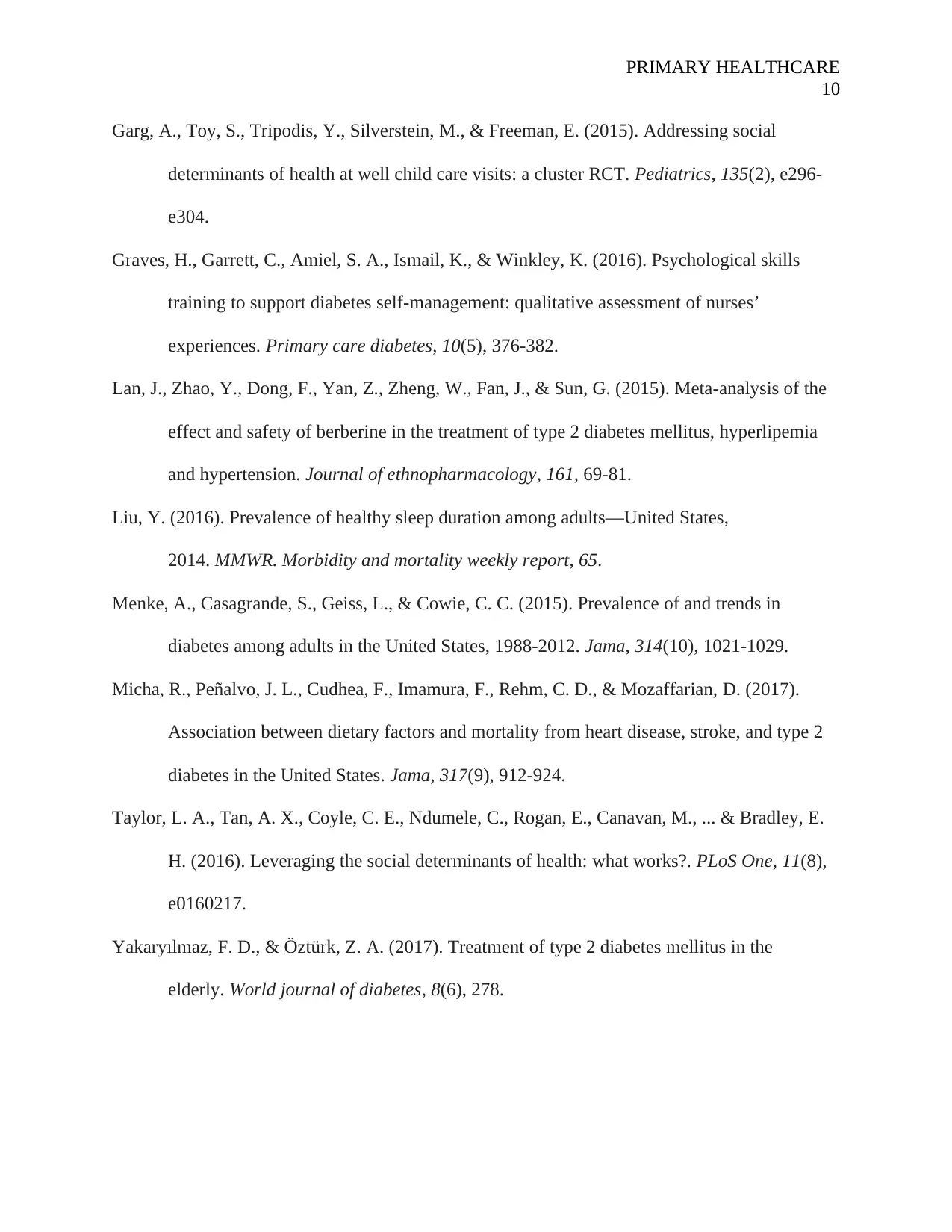
PRIMARY HEALTHCARE
10
Garg, A., Toy, S., Tripodis, Y., Silverstein, M., & Freeman, E. (2015). Addressing social
determinants of health at well child care visits: a cluster RCT. Pediatrics, 135(2), e296-
e304.
Graves, H., Garrett, C., Amiel, S. A., Ismail, K., & Winkley, K. (2016). Psychological skills
training to support diabetes self-management: qualitative assessment of nurses’
experiences. Primary care diabetes, 10(5), 376-382.
Lan, J., Zhao, Y., Dong, F., Yan, Z., Zheng, W., Fan, J., & Sun, G. (2015). Meta-analysis of the
effect and safety of berberine in the treatment of type 2 diabetes mellitus, hyperlipemia
and hypertension. Journal of ethnopharmacology, 161, 69-81.
Liu, Y. (2016). Prevalence of healthy sleep duration among adults—United States,
2014. MMWR. Morbidity and mortality weekly report, 65.
Menke, A., Casagrande, S., Geiss, L., & Cowie, C. C. (2015). Prevalence of and trends in
diabetes among adults in the United States, 1988-2012. Jama, 314(10), 1021-1029.
Micha, R., Peñalvo, J. L., Cudhea, F., Imamura, F., Rehm, C. D., & Mozaffarian, D. (2017).
Association between dietary factors and mortality from heart disease, stroke, and type 2
diabetes in the United States. Jama, 317(9), 912-924.
Taylor, L. A., Tan, A. X., Coyle, C. E., Ndumele, C., Rogan, E., Canavan, M., ... & Bradley, E.
H. (2016). Leveraging the social determinants of health: what works?. PLoS One, 11(8),
e0160217.
Yakaryılmaz, F. D., & Öztürk, Z. A. (2017). Treatment of type 2 diabetes mellitus in the
elderly. World journal of diabetes, 8(6), 278.
10
Garg, A., Toy, S., Tripodis, Y., Silverstein, M., & Freeman, E. (2015). Addressing social
determinants of health at well child care visits: a cluster RCT. Pediatrics, 135(2), e296-
e304.
Graves, H., Garrett, C., Amiel, S. A., Ismail, K., & Winkley, K. (2016). Psychological skills
training to support diabetes self-management: qualitative assessment of nurses’
experiences. Primary care diabetes, 10(5), 376-382.
Lan, J., Zhao, Y., Dong, F., Yan, Z., Zheng, W., Fan, J., & Sun, G. (2015). Meta-analysis of the
effect and safety of berberine in the treatment of type 2 diabetes mellitus, hyperlipemia
and hypertension. Journal of ethnopharmacology, 161, 69-81.
Liu, Y. (2016). Prevalence of healthy sleep duration among adults—United States,
2014. MMWR. Morbidity and mortality weekly report, 65.
Menke, A., Casagrande, S., Geiss, L., & Cowie, C. C. (2015). Prevalence of and trends in
diabetes among adults in the United States, 1988-2012. Jama, 314(10), 1021-1029.
Micha, R., Peñalvo, J. L., Cudhea, F., Imamura, F., Rehm, C. D., & Mozaffarian, D. (2017).
Association between dietary factors and mortality from heart disease, stroke, and type 2
diabetes in the United States. Jama, 317(9), 912-924.
Taylor, L. A., Tan, A. X., Coyle, C. E., Ndumele, C., Rogan, E., Canavan, M., ... & Bradley, E.
H. (2016). Leveraging the social determinants of health: what works?. PLoS One, 11(8),
e0160217.
Yakaryılmaz, F. D., & Öztürk, Z. A. (2017). Treatment of type 2 diabetes mellitus in the
elderly. World journal of diabetes, 8(6), 278.
Secure Best Marks with AI Grader
Need help grading? Try our AI Grader for instant feedback on your assignments.
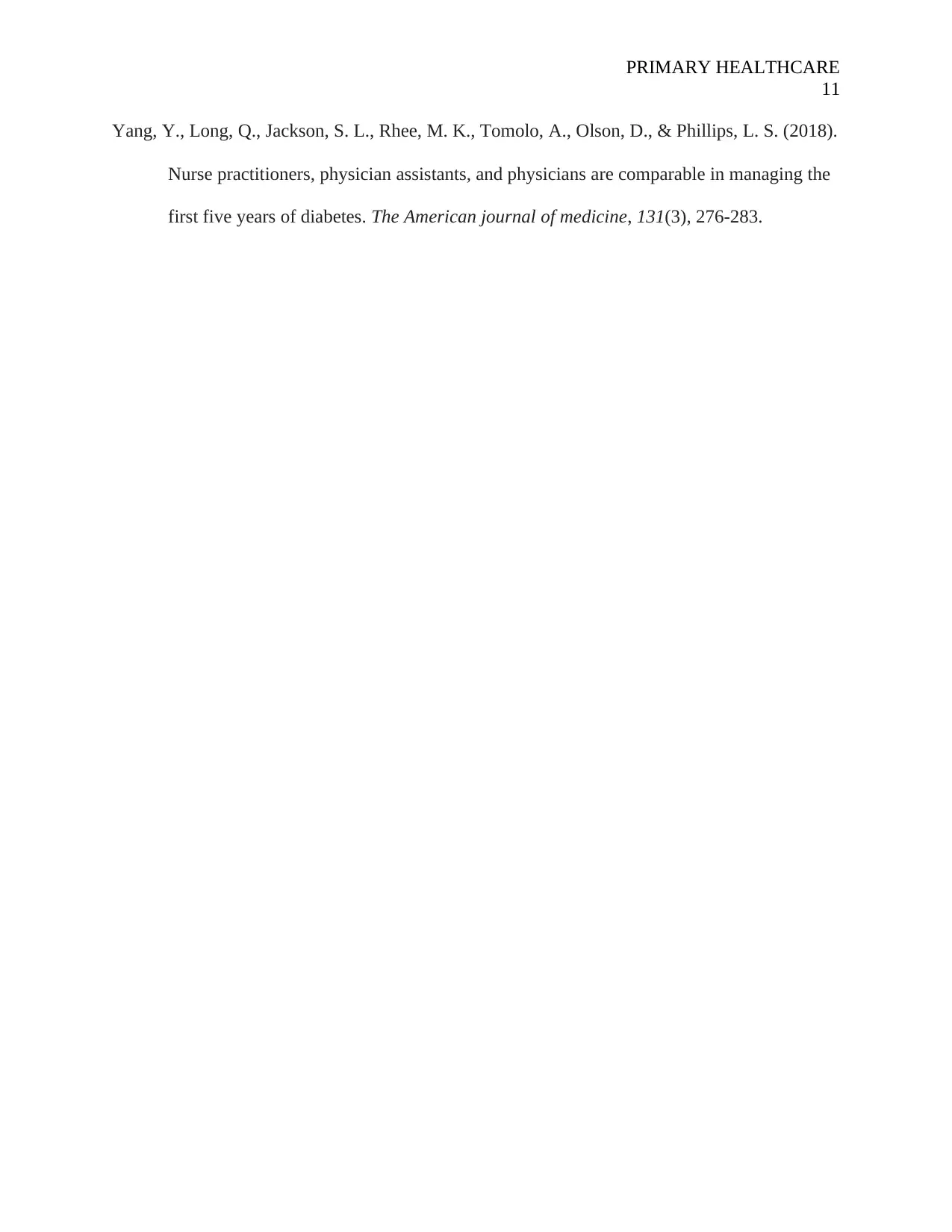
PRIMARY HEALTHCARE
11
Yang, Y., Long, Q., Jackson, S. L., Rhee, M. K., Tomolo, A., Olson, D., & Phillips, L. S. (2018).
Nurse practitioners, physician assistants, and physicians are comparable in managing the
first five years of diabetes. The American journal of medicine, 131(3), 276-283.
11
Yang, Y., Long, Q., Jackson, S. L., Rhee, M. K., Tomolo, A., Olson, D., & Phillips, L. S. (2018).
Nurse practitioners, physician assistants, and physicians are comparable in managing the
first five years of diabetes. The American journal of medicine, 131(3), 276-283.
1 out of 11
Related Documents
Your All-in-One AI-Powered Toolkit for Academic Success.
+13062052269
info@desklib.com
Available 24*7 on WhatsApp / Email
![[object Object]](/_next/static/media/star-bottom.7253800d.svg)
Unlock your academic potential
© 2024 | Zucol Services PVT LTD | All rights reserved.



